WIS 83.40 Automatic Climate Control (ACC) or Heating Ventilation and Air Conditioning (HVAC)
Description - Automatic Climate Control (ACC)
Heating Ventilation and Air Conditioning (HVAC) in a W220 S-Class is achieved by means of an electronically controlled Automatic Climate Control (ACC) system. The standard arrangement is a dual zone ACC with dual automatic or manual controls for temperature and air distribution. An optional four zone ACC is available.
Function - Automatic Climate Control (ACC)
The main functions of the ACC are:
Ventilation (Blower/s)
The low draft ventilation system:
- Is achieved by the ACC blower or the rear A/C blower.
- Looks after the air distribution in the vehicle interior.
- Supplies fresh or recirculated filtered air to the vehicle interior.
- Maintains a quick, quiet and comfortable vehicle interior.
- Distributes air within the vehicle via air distribution flaps.
- Prevents windows from fogging by fully opening the front and rear foot well flaps for 30s after the ignition is switched on.
Temperature Control
- The desired temperature is maintained by heating the air by operating the duo valves.
- The desired temperature is maintained by cooling the air by operating the refrigerant compressor.
- The basic temperature setting is 22ºC
- Accurate temperature control is achieved by monitoring the various temperature sensors such as:
- Left Heat Exchanger Temperature Sensor (B10/2)
- Right Heat Exchanger Temperature Sensor (B10/3)
- Evaporator Temperature Sensor (B10/6)
- Outside Temperature Sensor (B14)
- Sun Sensor (B32/2)
- Interior Temperature Sensor in ACC Pushbutton Control Module (N22) (N22/b1)
- Interior Temperature Sensor in Overhead Control Panel (OCP) (N70) (N70/b1)
- Temperature Sensor in Rear A/C Evaporator outlet for vehicles fitted with Code 582.
Electronic Control
- The ACC is controlled electronically by several control modules which are connected to the Can B (Interior) Bus. Each control module receives and sends digital messages across the CAN Bus.
Operator Control
- The ACC can be operated by pressing buttons on the ACC Pushbutton Control Module (N22) or on the Rear A/C in vehicles fitted with Code 582.
- The push button control module reads input from the sensors and actuates ACC components.
Heating
- Coolant which has been heated by the engine is pumped through the front and rear heat exchangers.
Cooling
- The ACC compressor pumps refrigerant through the A/C gas circuit where most compression heat is removed in the condenser and then the refrigerant is expanded through a valve into the evaporator where it absorbs heat from the ACC air flow.
Residual Heating/Cooling
- The REST button on the ACC Pushbutton Control Module (N22) allows limited heating and cooling of the vehicle interior even if the ignition is Off.
- The ACC blower runs for about 30 minutes and distributes residual heat or cool into the passenger compartment.
Special Features
- Electrostatic dust and pollen air filters.
- Activated Charcoal Filter with smog sensing automatic re-circulation of filtered cabin air.
- Tunnel mode closes all windows, the sun-roof and incoming air vents via the re-circulation button or ACF button.
- Humidity/dew-point sensor helps reduce window fogging during humid weather and helps prevent over drying of cooled air.
- Four way sun sensor helps compensate for the effects of directional sun light on the occupants.
- Seat belt usage sensors allows the ACC to focus first on occupied seating positions.
- Automatic mode for center dash vents.
Main In Cabin Components - Automatic Climate Control (ACC)
Pushbutton Control Module (N22)


Centre Vent Control Module (N18/4)

Overhead Control Panel (OCP) (N70)

“B” Pillar Vents

Right Side Outlet and Fixed Window and Door Vents

Left and Right Defroster Vents

Centre Vents with Optional A/C Control Module (N22/4) Rear Compartment

Blower Motor (A32m1)
Reference STAR Finder document GF83.10-P-2102-02I Blower, function.
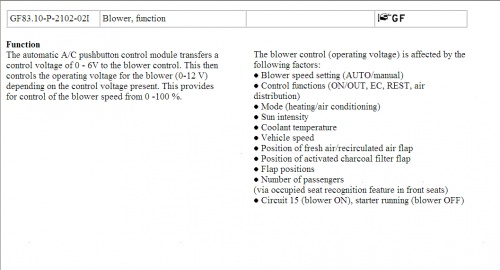
Blower Motor Regulator (A32n1)
Reference STAR Finder document GF83.10-P-2103-01I Blower regulator, function.
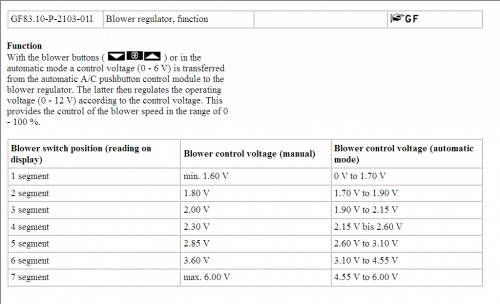
Thanks to BenzWorld Member cmitch, here is a photo of the Blower Regulator A32n1.
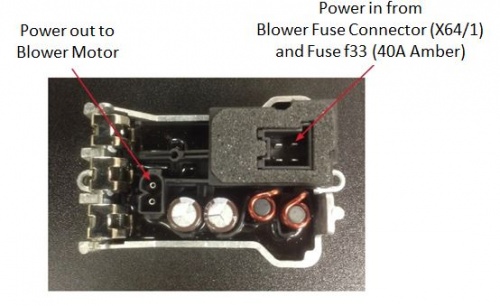
Location - Blower Motor and Regulator
Reference STAR Finder document GF83.10-P-2103-01I Blower motor and regulator, location.
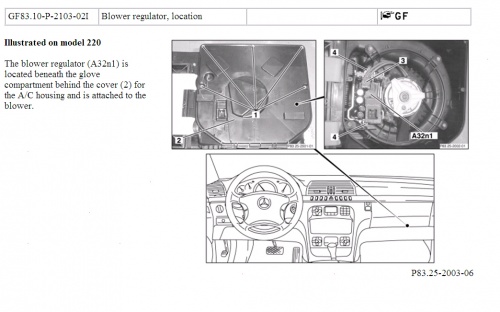
Circuit Diagram - Blower Motor and Regulator
Relevant part only shown.
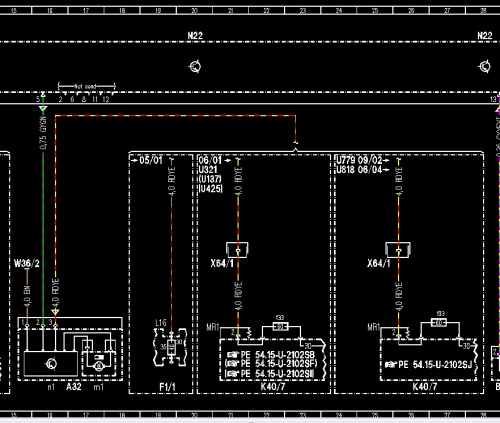
Main Engine Compartment Components - Automatic Climate Control (ACC)
Air Conditioning Compressor
Blower Fuse Connector X64/1
Located in Engine Compartment Right.
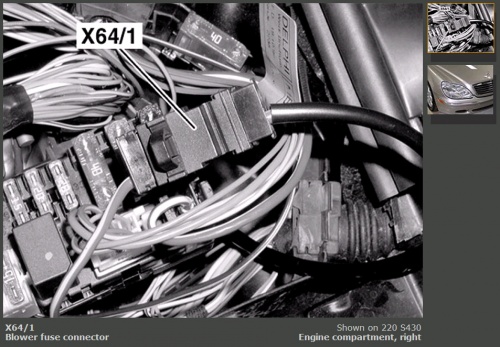
Blower Fuse f33
Located in Engine Compartment Right Front Fuse and Relay Module (K40/7).
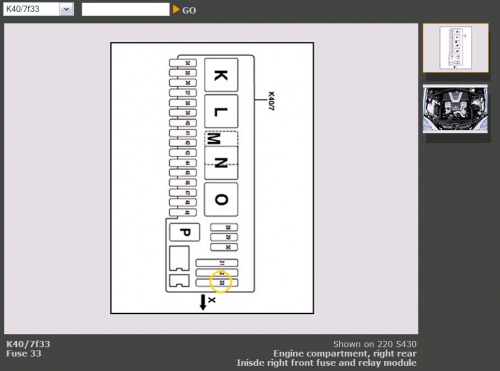
DIY Procedures - Automatic Climate Control (ACC)
Automatic Climate Control (ACC) Service Menus
Activated Charcoal Filter (ACF) or Aktivkohle Filter (AKF)
Blower
Cabin Ventilation Dust Filter
Coolant Circulation Pump
Duo Valve
Four Quadrant Sun Sensor (B32/2)
Pushbutton Control Module (N22)
In Cabin Air Temperature Sensor (N22/b1) and Aspirator in Pushbutton Control Module (N22)
Overhead Control Panel (OCP) (N70)
In Cabin Air Temperature Sensor (N70/b1) and Aspirator in Overhead Control Panel (OCP) (N70)
Multi-function Sensor (B31/1)
Location and Access - Multi-function Sensor (B31/1)
Remove two screws and gently withdraw the Multi-function Sensor (B31/1) located at right rear corner of engine compartment
RH Drive W220) adjacent to the fresh air intake.
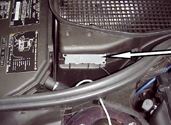
Access and Testing - Multi-function Sensor (B31/1)
CO Carbon Monoxide Access and Testing (B31/1)
Multi-function Sensor (B31/1) CO Carbon Monoxide Access and Testing
Monitor Diagnostic Parameter NR.16: and breathe heavily on both sensors. Start value: 683 which reduced to 681. Conclusion: Result is inconclusive.
NOx Nitrogen Oxide Access and Testing (B31/1)
Dew Point Temperature Access and Testing (B31/1)
Multi-function Sensor (B31/1) Dew Point Temperature Access and Testing
Monitor Diagnostic Parameter NR.18: and breathe heavily on both sensors. Start value: 15.5 ºC which increased to 20.5 ºC. Conclusion: Sensitivity of sensor seems OK.
Outside Temperature Sensor (B14)
R134A Refrigerant Temperature Sensor (B12/1)
Repair Air Conditioning System
Under Hood ACC Drain Access and Cleaning
Evaporator Temperature Sensor (B10/6)
Evaporator temperature sensor A2208300772 (~EUR 15) is plugged in the left side of evaporator.
| Error Code | Generated By | Description |
|---|---|---|
| B1256 | AAC - Automatic air conditioning | B10/6 (Evaporator temperature sensor), Evaporator Front |
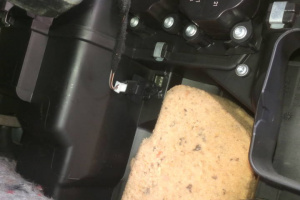 |
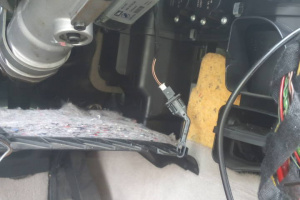 |
Replace Evaporator Temperature Sensor
If your A/C suddenly starts to blow warm air, your Evap Temp Sensor may need to be replaced. If your S class A/C works for 10 minutes and then dies, and if this behavior continues every time you reset the A/C faults (video shows how to reset errors), you most certainly need to replace your Evap Temp Sensor.
You should also replace it as a very cheap maintenance item if your mileage is above 100,000 miles.
Part number is 220-830-07-72-M6 - you can purchase the Behr model from Pelican Parts at $16 as of 8/24/2019.
Entertainment - Automatic Climate Control (ACC)
How to replace W220 Evaporator Fantastic Video (Warning! Turn your sound down.)
Testing In Cabin Air Temperature Sensor (N22/b1) and Aspirator in ACC Pushbutton Control Module (N22)
Test the function of the In Car Temperature Sensor Control Module (N22)
Monitor Diagnostic Parameter NR.00: and place a pre-warmed hair drier over the slotted vent in the Pushbutton Control Module (N22).
Test Results Start temperature: 26.3ºC which increased to 29.3ºC very quickly and then returned to 25.6ºC very quickly after the heat was removed.
Conclusion Sensitivity of sensor seems OK.
Test the function of the Aspirator Motor for the In Car Temperature Sensor (N22/b1) in the Pushbutton Control Module (N22)
With the fan speed on manual Max 7 Bars, hold a narrow piece of tissue paper near the vented slots in the Pushbutton Control Module (N22) and note any tendency for the paper to be drawn onto the vent.
Test Results
The paper should adhere to the vent.
Testing - In Cabin Air Temperature Sensor (N22/b1)
This section describes the method for testing the In Cabin Air Temperature Sensor (N22/b1) and the Aspirator in ACC Pushbutton Control Module (N22)

Temperature Sensitivity Test - In Cabin Air Temperature Sensor (N22/b1)
Monitor Diagnostic Parameter NR.00: and place a pre-warmed hair drier over the slotted vent in the Pushbutton Control Module (N22).
Test Results
Start temperature: 26.3ºC which increased to 29.3ºC very quickly and then returned to 25.6ºC very quickly after the heat was removed.
Conclusion
Sensitivity of sensor seems OK.
Aspirator Function Test - In Car Temperature Sensor Control Module (N22)
With the fan speed on manual Max 7 Bars, hold a narrow piece of tissue paper near the vented slots in the Pushbutton Control Module (N22) and note any tendency for the paper to be drawn onto the vent.
Test Results
The paper adheres quite strongly to the vent.
Conclusion
The function of the Aspirator appears OK.
DIY Repair - In Cabin Air Temperature Sensor (N22/b1)
If either or both the In Cabin Air Temperature Sensor (N22/b1) and the Aspirator in ACC Pushbutton Control Module (N22) failed the above tests see section Pushbutton Control Module (N22).
Resistance Specification - In Cabin Air Temperature Sensor
Thermistor Theory
Understanding some of the theory of thermistors will help if you have to purchase a replacement thermistor with a slightly different Beta value.
A thermistor is just a temperature dependent resistor. Unfortunately, its dependence is highly nonlinear.
The standard formula for a NTC-thermistor resistance as a function of temperature is as follows;

Where;
- RT is the thermistor's resistance at temperature T,
- R25C is the thermistor’s nominal resistance in K Ohms at a room temperature of 25C,
- ß is the exponential factor known as "Beta" value or sensitivity index of the thermistor material constant in degrees Kelvin
- T is the thermistor’s actual temperature in degrees Celsius
- e is the exponential function
Thermistors with slightly different Beta values are available so the question arises, does this matter? The following graphs were prepared for four Beta values, 4050K, 3750, 3530 and 3435K. If you find a thermistor with a Beta value between 3435K and 4050K your resistance versus temperature graph will be between the shown results.
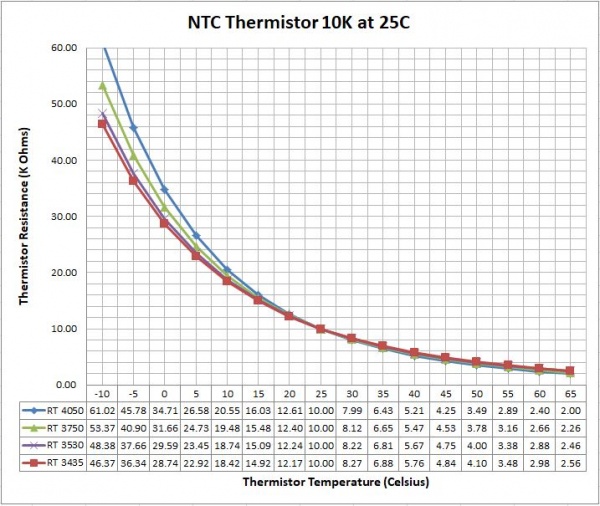
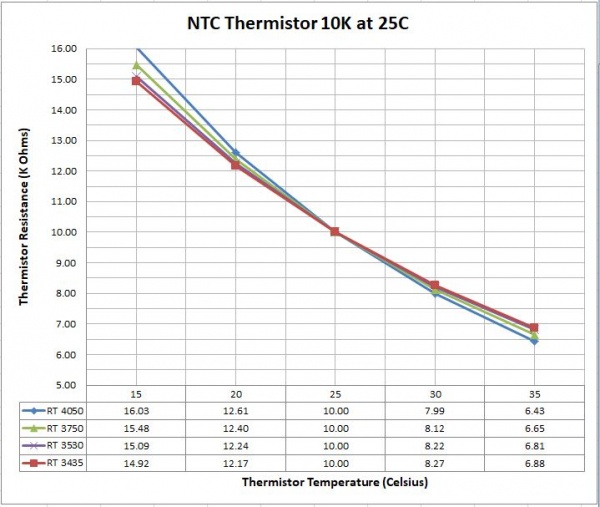
The bottom line is that having a Beta value between 3435K and 4050K will not make much difference to the ACC performance in the normal comfort zone of 20C to 30C.
Resistance Specification - In Cabin Air Temperature Sensors
This section applies to both In Cabin Air Temperature Sensors. The OEM sensors were found to be not identical in appearance although their electrical properties were very similar.
- Sensor N22/b1 which is in Pushbutton Control Module (N22),
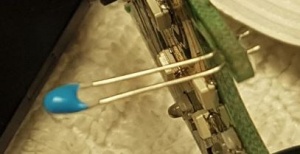
- Sensor N70/b1 which is in Overhead Control Panel N70.
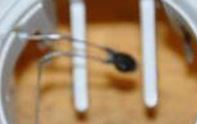
The specification for the OEM Thermistors as used in the W220 ACC is not available but was determined by removing both sensors from their respective modules and measuring their resistances using a DMM. The sensors were connected to the DMM and placed near a Digital Thermometer and allowed to stabilise at the local temperature for at least 20 minutes. The different temperatures were achieved by using different rooms and different times of the day. The results were then matched to the theoretical results as shown in the graphs above.
Measured results were;
- Sensor N22/b1 (Black in colour) removed from Pushbutton Control Module (N22); 9.88K Ohms at 25.37C (couldn't get exactly 25C) and 7.92K Ohms at 30.68C,
- Sensor N70/b1 (Blue in colour) removed from Overhead Control Panel (N70); 10.00K Ohms at 25C and 7.15K Ohms at 33.7C.
Deduced OEM Thermistor Specifications
- Thermistor Type NTC (Negative Temperature Coefficient),
- Nominal Value 10K Ohms at 25C,
- Diameter 2mm.
- Sensor N22/b1 (Black in colour) in Pushbutton Control Module B Constant 3750K,
- Sensor N70/b1 (Blue in colour) in Overhead Control Panel B Constant 3530K,
- Temperature -30°C to +125°C,
- Tolerance ±1%,
Replacement Thermistors are available from electronic parts stores and also eBay. With a little bit of searching you can find thermistors with almost identical properties. One BenzWorld Poster was able to purchase a 10K Ohm NTC Thermistor with the following specification;
- Thermistor Type NTC (Negative Temperature Coefficient),
- Nominal Value 10K Ohms at 25C,
- Diameter 5mm.
- B Constant 4050K,
- Temperature -30°C to +125°C,
- Tolerance ±5%,

Notes:
- These are not a perfect match as the Beta value is a bit high.
- A thermistor with a tolerance of 1% would be a better match.
- 1% is 10K +/- 0.1K which is equivalent to 25C +/- 0.2C and
- 5% is 10K +/- 0.5K which is equivalent to 25C +/- 1.0C.
- The thermistor shown is much larger than the OEM thermistor, and will consequently have a larger thermal mass making it a bit slower to respond to temperature changes compared to the smaller OEM one. However one BenzWorld Poster reports that it worked like a charm. The BenzWorld Poster had to wire the larger thermistor external of the fan housing and allow for some slack in the leads so the plastic fan shroud fitted properly.
In Cabin Air Temperature Sensor (N70/b1) and Aspirator in Overhead Control Panel (OCP) (N70) Testing
Testing In Cabin Air Temperature Sensor (N70/b1) and Aspirator in Overhead Control Panel (OCP) (N70)
Note on the W220 there are two slotted vents (Left and Right) in the Overhead Control Panel (OCP). Only the Right Vent (LHD and RHD cars) has an air temperature sensor with an aspirator.
Testing In Cabin Air Temperature Sensor (N70/b1) in Overhead Control Panel (OCP) (N70)
Monitor Diagnostic Parameter NR.01: in the W220_Pushbutton_Control_Module_N22.
Place a pre-warmed hair drier over the Right slotted vent in the Overhead Control Panel (OCP).
Test Results: Start temperature: 25.7ºC which instantly increased to 32.5ºC and then returned to 26.7ºC very quickly after the heat was removed.
Conclusion: Sensitivity of In Cabin Air Temperature Sensor (N70/b1) seems OK.
Testing In Cabin ACC Aspirator in Overhead Control Panel (OCP) (N70)
With the ACC fan speed on manual Max 7 Bars, hold a narrow piece of tissue paper near the Right Vented Slot and note any tendency for the paper to be drawn onto the vent.
Test Results: The paper should adhere to the vent.
Conclusion: Strong adherence noted hence excellent Aspirator Motor Function.
In Cabin Air Temperature Sensor (N70/b1) and Aspirator in Pushbutton Control Module (N22) and in Overhead Control Panel (OCP) (N70) Resistance Specification
Thermistor from ebay, 10 x 10K OHM NTC Thermistor 5mm - USA Seller - Free Shipping Specification
- B Constant 4050K
- Temperature -30°C to +125°C
- Thermistor Type NTC Thermistor
- Tolerance ±5%
This part is much larger than the original thermistor, but it works like a charm. The BenzWorld Poster had to wire the new thermistor external of the fan housing and allow for slack so the plastic housing fitted properly.
http://www.benzworld.org/forums/w220-s-class/1460424-need-help-c-diag-new-post.html
Multi-function Sensor (B31/1) CO Carbon Monoxide Access and Testing
Monitor Diagnostic Parameter NR.16: and breathe heavily on both sensors. Start value: 683 which reduced to 681. Conclusion: Result is inconclusive.
Multi-function Sensor (B31/1) Dew Point Temperature Access and Testing
Monitor Diagnostic Parameter NR.18: and breathe heavily on both sensors. Start value: 15.5 ºC which increased to 20.5 ºC. Conclusion: Sensitivity of sensor seems OK.
Multi-function Sensor (B31/1) Location and Access
Remove two screws and gently withdraw the Multi-function Sensor (B31/1) located at right rear corner of engine compartment (RH Drive W220) adjacent to the fresh air intake.
Multi-function Sensor (B31/1) NOx Nitrogen Oxide Access and Testing
Monitor Diagnostic Parameter NR.17: and breathe heavily on both sensors. Start value: 116 which reduced to 114. Conclusion: Result is inconclusive.
Multi-function Sensor (B31/1) NOx Nitrogen Oxide Access and Testing
Monitor Diagnostic Parameter NR.17: and breathe heavily on both sensors. Start value: 116 which reduced to 114. Conclusion: Result is inconclusive.
Outside Temperature Sensor (B14)
Testing - Outside Temperature Sensor (B14)
- Monitor Diagnostic Parameter NR.02: using the ACC Pushbutton Control Module (N22).
- Apply direct heat using an hair drier to the Outside Temperature Sensor B14 located in the small left front air scoop below the front bumper).
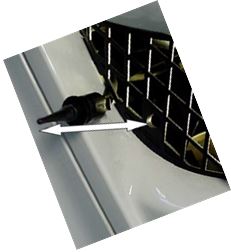
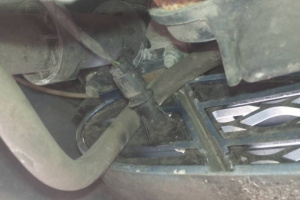 |
 |
 |
Test Results - Outside Temperature Sensor (B14)
Start temperature: 24.7 ºC which quickly increased to 50.5ºC and then slowly returned to 33.7ºC after the heat was removed. (Note there was no air flow over the Outside Temperature Sensor B14 as the car was stationary.)
Conclusion:
Sensitivity of sensor seems OK.
R134A Refrigerant Temperature Sensor (B12/1)
Testing - R134A Refrigerant Temperature Sensor (B12/1)
Monitor Diagnostic Parameter NR.08: and apply direct heat using an hair drier to the R134A Refrigerant Temperature Sensor B12/1 (located on top of the air conditioner receiver drier at the front left corner of the engine compartment).
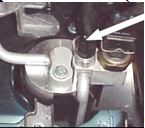
Test Results - R134A Refrigerant Temperature Sensor (B12/1)
Start temperature: 23.5ºC which increased to 30.5ºC very slowly due to the mass of metal to be heated.
Conclusion:
Sensitivity of sensor seems OK.
Resistance Specification - In Cabin Air Temperature Sensor (N22/b1)
The resistance specification for the In Cabin Air Temperature Sensor (N22/b1) is presumed to be the same as In Cabin Air Temperature Sensor (N70/b1) and Aspirator in Overhead Control Panel (OCP) (N70).